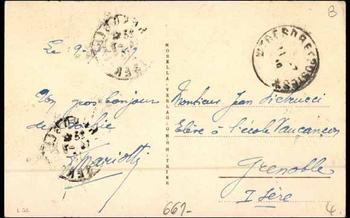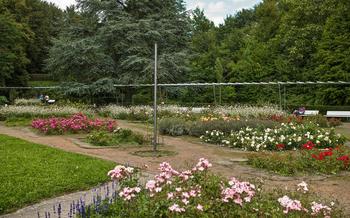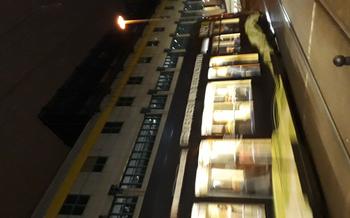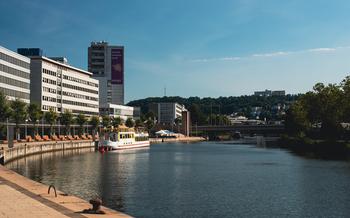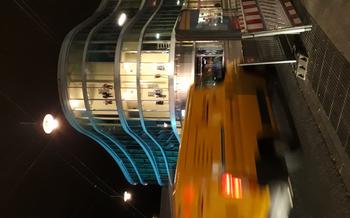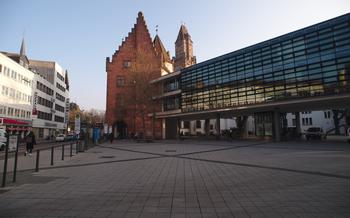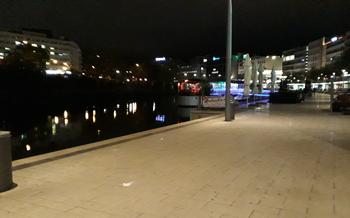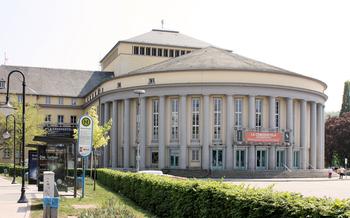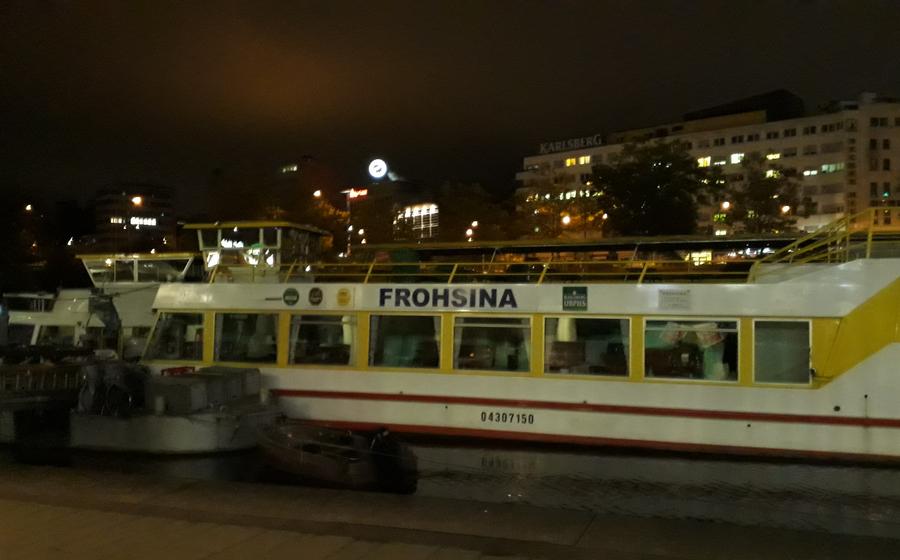
Völklingen Ironworks UNESCO World Heritage Site
- Völklingen Ironworks: A Legacy of Industrial Engineering
- Exploring the Vast Industrial Complex
- A Journey Through Time: Guided Tours
- Interactive Exhibits and Installations: Engaging Visitors with History and Technology
- Preserving Industrial Heritage: The Ironworks Today
- UNESCO World Heritage Site: Global Recognition
- Architectural Masterpiece: Functionalism and Aesthetics
- Coking Plant: Transforming Coal into Coke
- Water Management: A Crucial Aspect of Ironmaking
- The People Behind the Ironworks
- From Industry to Culture: The Ironworks' Transformation
- Events and Exhibitions: A Vibrant Cultural Hub
- Insider Tip: Photography Opportunities
Völklingen Ironworks: A Legacy of Industrial Engineering
The Völklingen Ironworks, a former industrial complex located in Völklingen, Saarland, Germany, stands as a testament to the region's rich industrial heritage. Its history dates back to the mid-19th century when the Stumm family, renowned industrialists and pioneers in the iron and steel industry, established the ironworks.
Over the years, the ironworks underwent several expansions and modernizations, transforming into a vast and technologically advanced industrial complex. The site encompassed blast furnaces, a coking plant, a gas network, and various other facilities, all integrated into a seamless production process. The ironworks played a pivotal role in the industrial development of Saarland, contributing to its economic growth and establishing the region as a significant center for iron and steel production.
In recognition of its outstanding architectural, engineering, and historical significance, the Völklingen Ironworks was designated a UNESCO World Heritage Site in 199This prestigious designation acknowledges the ironworks' exceptional universal value and its importance as a symbol of Saarland's industrial heritage, showcasing the region's contribution to the development of modern industrial processes.
Exploring the Vast Industrial Complex
The Völklingen Ironworks is a sprawling complex that once housed a multitude of industrial processes, each contributing to the production of iron. Its size and layout are awe-inspiring, with towering blast furnaces, a coking plant, and numerous other facilities spread across the site.
The ironworks can be broadly divided into different sections, each with its own specific function. The most prominent feature is the blast furnace complex, where iron ore was smelted to produce molten iron. The coking plant, located nearby, transformed coal into coke, which was essential for the smelting process. Other facilities included a power plant, a gas network, and a water management system, all of which played vital roles in supporting the ironmaking operations.
The integration of these various processes within the ironworks was a marvel of industrial engineering. Raw materials were meticulously transported and transformed through a series of interconnected steps, optimizing efficiency and minimizing waste. The result was a seamless production process that showcased the technological prowess of the era.
A Journey Through Time: Guided Tours
Immerse yourself in the captivating history of the Völklingen Ironworks with guided tours that bring the site's industrial past to life. Conducted in various languages, these tours offer a range of options tailored to different interests and knowledge levels.
Join an experienced guide and embark on a journey through time as you explore the vast industrial complex. Learn about the ironmaking process, from the extraction of raw materials to the production of molten iron. Discover the significance of the blast furnaces, coking plant, and other facilities that played crucial roles in the ironworks' operations.
The duration of the tours varies, allowing you to choose an experience that fits your schedule. Highlights include visits to the blast furnaces, the coking plant, and the gas network, where you'll gain insights into the technological innovations that revolutionized the iron and steel industry.
Through these guided tours, you'll not only witness the impressive scale and grandeur of the ironworks but also gain a deep understanding of the industrial heritage of Saarland and its global significance.
Interactive Exhibits and Installations: Engaging Visitors with History and Technology
The Völklingen Ironworks brings history and technology to life through its interactive exhibits and installations. Multimedia displays and storytelling techniques immerse visitors in the ironmaking process and the daily lives of the workers. Visitors can interact with hands-on exhibits to gain a deeper understanding of the industrial processes and the challenges faced by the ironworkers. These innovative displays not only educate but also captivate visitors, creating a lasting impression of the ironworks' significance and legacy.
Virtual Reality Experience:
Step into a virtual reality simulation that transports visitors back in time to the bustling ironworks. Experience the sights, sounds, and smells of a working blast furnace, and witness the grueling work of the ironworkers. This immersive experience provides a unique and unforgettable glimpse into the industrial past.
Interactive Touchscreens:
Interactive touchscreens offer in-depth information on the various aspects of ironmaking. Visitors can explore interactive maps, diagrams, and historical photographs to learn about the different sections of the ironworks, the technologies used, and the lives of the workers.
Hands-on Demonstrations:
Live demonstrations and hands-on activities allow visitors to engage with the ironmaking process in a practical way. Learn how to operate a miniature blast furnace, cast molten iron, or forge metal using traditional techniques. These interactive experiences provide a deeper understanding of the skills and craftsmanship required in the iron and steel industry.
Preserving Industrial Heritage: The Ironworks Today
The Völklingen Ironworks, once a bustling center of industrial activity, has undergone a remarkable transformation from an active production site to a vibrant cultural landmark. Recognizing its immense historical and architectural significance, extensive restoration and preservation efforts were undertaken to ensure its legacy endures for generations to come.
The ironworks' metamorphosis into a cultural hub involved a careful balancing act between preserving its industrial heritage and adapting it to modern cultural uses. The site's iconic structures, including the blast furnaces, coking plant, and gas network, were meticulously restored, retaining their original character while ensuring their safety and accessibility for visitors.
Adaptive reuse played a crucial role in the ironworks' revitalization. The former industrial buildings were repurposed to host a variety of cultural events, exhibitions, and educational programs. This creative approach not only preserved the site's industrial heritage but also breathed new life into its spaces, transforming them into vibrant venues for cultural expression and community engagement.
UNESCO World Heritage Site: Global Recognition
The Völklingen Ironworks' designation as a UNESCO World Heritage Site in 1994 marked a significant milestone in its history. This prestigious recognition highlights the outstanding universal value of the site, which embodies the significant technological advancements and industrial heritage of the 19th and 20th centuries. The ironworks' inclusion on the World Heritage List underscores the importance of preserving and protecting industrial heritage sites that bear exceptional cultural and historical significance. This recognition serves as a testament to the ironworks' global importance, attracting visitors from around the world who seek to witness and learn from this remarkable industrial monument.
Architectural Masterpiece: Functionalism and Aesthetics
The Völklingen Ironworks stands out for its unique architectural style, a blend of functionalism and aesthetics. Functionalist principles were central to the design, prioritizing efficiency and practicality in every aspect of the ironworks. The buildings were constructed using steel frames and reinforced concrete, showcasing the latest in industrial construction techniques.
The architects skillfully integrated aesthetic considerations into the functional design, resulting in a harmonious balance between form and function. The towering blast furnaces, with their cylindrical shapes and intricate brickwork, are striking examples of industrial beauty. The interplay of light and shadow on the iron structures creates a captivating visual experience, transforming the ironworks into a work of art.
This fusion of functionality and aesthetics is evident throughout the site. The arrangement of buildings, the flow of materials, and the integration of technology all contribute to the efficient operation of the ironworks while simultaneously creating a visually stunning industrial landscape. The Völklingen Ironworks is a testament to the ingenuity and creativity of its architects, who successfully married practicality with beauty.
Coking Plant: Transforming Coal into Coke
The coking plant at the Völklingen Ironworks played a crucial role in the ironmaking process. Its primary function was to transform coal into coke, a key ingredient in iron smelting. Coke, a porous and carbon-rich fuel, was produced through the process of carbonization, which involved heating coal in the absence of oxygen. This process expelled volatile compounds from the coal, leaving behind a hard, carbon-rich residue known as coke.
The coking plant consisted of a battery of ovens, each capable of holding several tons of coal. The coal was loaded into the ovens, and the doors were sealed. The ovens were then heated to extremely high temperatures, typically around 1000 degrees Celsius. The heating process drove off the volatile compounds, which were captured and used as fuel for other processes within the ironworks.
The coking process typically lasted for several days, after which the coke was quenched with water to cool it down and make it easier to handle. The resulting coke was then transported to the blast furnaces, where it served as a fuel source for the iron smelting process.
The coking plant at the Völklingen Ironworks was a vital part of the integrated ironmaking process. It provided the necessary coke for the blast furnaces and contributed to the efficient utilization of resources within the ironworks. Today, the coking plant stands as a testament to the technological advancements and industrial ingenuity of the past, showcasing the crucial role of coke in the ironmaking industry.
Water Management: A Crucial Aspect of Ironmaking
Water played a fundamental role in the ironmaking process at the Völklingen Ironworks. Waterwheels, powered by the Saar River, provided the energy to operate bellows that generated the intense heat necessary for the blast furnaces. These waterwheels also pumped water from the river to the top of the blast furnaces, where it was used to cool the escaping gases.
An extensive network of canals and reservoirs was constructed to ensure a steady supply of water to the ironworks. These canals also served as a means of transporting raw materials and finished products. The efficient use of water resources was crucial for the success of the ironworks, as it was essential for powering the machinery, cooling the furnaces, and transporting goods.
The water management system at the Völklingen Ironworks was a testament to the ingenuity and engineering prowess of the ironmasters. By harnessing the power of water, they were able to create an industrial complex that was both efficient and productive. Today, the canals and reservoirs that once served the ironworks stand as a reminder of its rich history and its importance to the development of the Saarland region.
The People Behind the Ironworks
The Völklingen Ironworks was not merely a collection of machines and structures; it was a thriving community of workers who dedicated their lives to the production of iron. These men and women came from diverse backgrounds, bringing with them their skills, experiences, and aspirations.
Their working conditions were often harsh and demanding. The ironworks operated around the clock, and the workers toiled in shifts, enduring extreme temperatures, noise, and physical exertion. They faced risks of accidents and injuries, and their health was often affected by exposure to dust, fumes, and chemicals.
Beyond the factory gates, the ironworks had a profound impact on the surrounding community. It provided employment and sustenance to thousands of families, shaping the social and economic fabric of the region. The workers formed a close-knit community, united by their shared experiences and struggles.
Their stories and experiences offer a glimpse into the human dimension of industrial heritage. The ironworks was not just a place of production; it was a place where people lived, worked, and shaped their lives. Their dedication and resilience are a testament to the spirit of innovation and perseverance that drove the industrial revolution.
Labor unions played a crucial role in advocating for the rights and welfare of the workers. They fought for better working conditions, safer practices, and fair wages. Their efforts contributed to the gradual improvement of labor standards and the recognition of workers' rights.
The ironworks also had a significant impact on the social and cultural life of the region. Workers formed sports clubs, music groups, and other social organizations, fostering a sense of community and belonging. These initiatives not only provided leisure activities but also contributed to the cultural vibrancy of the area.
The people behind the Völklingen Ironworks were the driving force behind its success. Their hard work, dedication, and resilience made the ironworks a symbol of industrial progress and innovation. Their stories and experiences remind us of the human dimension of industrial heritage and the importance of recognizing the contributions of the workers who shaped our modern world.
From Industry to Culture: The Ironworks' Transformation
The decline of the iron and steel industry in Saarland, particularly after World War II, led to the closure of the Völklingen Ironworks in 198This closure had a significant impact on the region, as the ironworks had been a major employer and a driving force of the local economy. In the face of this industrial decline, revitalization efforts and cultural initiatives emerged as a means to preserve the heritage of the ironworks and promote its transformation into a cultural and heritage site.
The closure of the ironworks marked a turning point in the history of the site, as it shifted from being a center of industrial production to a hub of cultural and heritage activities. This transition involved careful planning and collaboration between various stakeholders, including the government, cultural organizations, and the local community. Their collective efforts focused on preserving the unique industrial heritage of the ironworks while adapting it to new cultural and educational purposes.
The transformation process involved the restoration and preservation of the existing structures, ensuring that the historical integrity and authenticity of the site were maintained. Simultaneously, new cultural initiatives were introduced, such as art exhibitions, music festivals, and educational programs. These initiatives aimed to revitalize the site, attract visitors, and showcase the rich industrial heritage of the region.
Today, the Völklingen Ironworks stands as a testament to the successful transformation of an industrial site into a vibrant cultural hub. It serves as a reminder of the region's industrial past while embracing a new identity as a center for cultural events, exhibitions, and educational programs.
Events and Exhibitions: A Vibrant Cultural Hub
Beyond its historical significance, the Völklingen Ironworks has transformed into a vibrant cultural hub, hosting a variety of events and exhibitions that breathe life into its industrial heritage. Art exhibitions showcasing contemporary and modern works find a unique backdrop within the ironworks' vast halls, where towering structures and intricate machinery provide an awe-inspiring ambiance. Music festivals and concerts resonate through the industrial spaces, creating an unforgettable atmosphere as melodies intertwine with the echoes of the ironworks' past. Cultural events, such as theater performances, dance shows, and historical reenactments, bring the ironworks' rich history to life, immersing visitors in the stories of the people who once worked and lived here. By hosting these diverse cultural events, the Völklingen Ironworks not only preserves its industrial heritage but also transforms it into a dynamic and engaging space for artistic expression and community gathering.
Insider Tip: Photography Opportunities
The Völklingen Ironworks presents a treasure trove of photography opportunities for enthusiasts and casual photographers alike. The site's unique industrial aesthetics and historical charm make it a captivating subject to capture through the lens.
With its towering blast furnaces, intricate machinery, and sprawling structures, the ironworks offers endless possibilities for capturing striking images. The play of light and shadow on the metallic surfaces, the juxtaposition of old and new elements, and the sheer scale of the site provide a photographer's paradise.
Photographers can explore the various sections of the ironworks, from the blast furnaces and coking plant to the gas network and water management systems, to find unique perspectives and compositions. The interplay of colors, textures, and shapes creates a visually stunning backdrop for photography.
To make the most of your photography experience at the Völklingen Ironworks, consider visiting during different times of the day and under various weather conditions. The changing light throughout the day can dramatically alter the mood and atmosphere of the site, offering diverse photographic opportunities.
Remember to bring a camera with a wide-angle lens to capture the vastness of the ironworks and a tripod for stability when shooting in low-light conditions. Additionally, a polarizing filter can help reduce glare and enhance the colors of the metallic surfaces.
As you explore the ironworks with your camera, be mindful of safety regulations and any restricted areas. Respect the privacy of visitors and workers, and always ask for permission before photographing people.
Whether you're a professional photographer or simply enjoy capturing beautiful images, the Völklingen Ironworks offers a truly unique and inspiring setting for photography. Embrace the opportunity to document the industrial heritage of this remarkable site and share your creative vision with the world.

